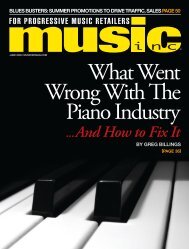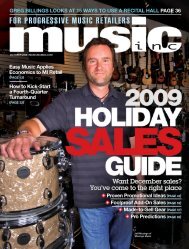Create successful ePaper yourself
Turn your PDF publications into a flip-book with our unique Google optimized e-Paper software.
One major manufacturer<br />
recently published a stocking<br />
requirement that is 50 percent<br />
of its dealers’ annual sales target.<br />
It would be pretty hard to<br />
find a CPA or banker who’s<br />
impressed with a two-time<br />
inventory turn. Maybe the reason<br />
inventory turns are so anemic<br />
in our industry isn’t<br />
because sales are too low.<br />
Maybe our stocking levels are<br />
too high. Grocery stores turn<br />
their inventory 20–30 times a<br />
year, and bakers and fish mongers<br />
turn it once a day. Is three<br />
times a year too much to ask<br />
for guitars?<br />
Calculating an inventory<br />
turn is actually easy. Just divide<br />
the total cost of goods sold by<br />
the total inventory on hand. If<br />
the year-end inventory isn’t a<br />
fair representation, the average<br />
inventory level at the end of<br />
each quarter will do.<br />
My colleague and financial<br />
guru Alan Friedman has an<br />
exquisite formula for calculating<br />
inventory turn as part of a<br />
purchasing decision:<br />
“Take the gross profit percent<br />
you expect to achieve and<br />
multiply it by 360 (days in a<br />
year). The result is how many<br />
days you have to sell all quantities<br />
of that item. If you can’t<br />
sell them in that time frame,<br />
reduce your order until the<br />
answer is yes.<br />
“For example, consider buying<br />
a trumpet that sells for<br />
$400 and costs $300, producing<br />
$100 of gross profit. One<br />
hundred dollars represents a<br />
25-percent ($100/$400) gross<br />
profit. Multiply 0.25 times 360,<br />
and you’ll get 90. Ask yourself:<br />
Can I sell all of these trumpets<br />
in 90 days? If the answer is<br />
‘yes,’ buy it all. If the answer is<br />
‘no,’ reduce the quantity until<br />
the answer is ‘yes.’ This formula<br />
considers profit and time<br />
(or turns) in determining what<br />
and how many to buy.”<br />
Simply stated: The lower<br />
your gross profit is, the faster<br />
you must sell the items and<br />
vice versa.<br />
AVOID PITFALLS<br />
Alan’s formula is a great<br />
place to start, and his discipline<br />
would improve the bottom<br />
line of most music<br />
retailers. It’s hard to imagine<br />
that a music store that turns<br />
inventory three times a year<br />
wouldn’t be highly profitable<br />
with excellent cash flow. But<br />
even this formula may be too<br />
liberal for the selling environment<br />
we find ourselves in<br />
today. A two-time turn of a 50percent<br />
gross item may be<br />
acceptable on paper, but I think<br />
we can do even better if we<br />
realize that customers neither<br />
need nor want as many choices<br />
as we are offering. Presenting<br />
too many options is probably<br />
why our prospects so often tell<br />
us they’re confused.<br />
Nothing plumps up inventory<br />
like carrying competing<br />
brands. The allure is that having<br />
both lines guarantees a sale,<br />
but it doesn’t. Too many lines<br />
kill turns, confuse staff and<br />
customers, and erode vendor<br />
relationships. Sometimes, the<br />
best thing to do is just decide<br />
which product offers the best<br />
customer value and profit<br />
potential, and commit to it.<br />
Most of us are obsessed with<br />
gross margin as the path to net<br />
profit, but increasing inventory<br />
turn can also generate cash.<br />
Let’s say you invested $4,000 in<br />
a sousaphone that you hope to<br />
sell for $7,995 within six<br />
months. You’d have a $3,995<br />
gross profit and $4,000 to reinvest.<br />
However, if you could sell<br />
one unit at $4,995 in one<br />
month, generating a $995 GP,<br />
and repeated that each month<br />
for six months, you would generate<br />
$5,970 in GP on the same<br />
$4,000 investment. (If you rein-<br />
‘Maybe the<br />
reason<br />
inventory turns<br />
are so anemic<br />
isn’t because<br />
sales are too<br />
low. Maybe our<br />
stocking levels<br />
are too high.’<br />
vested the profit as you went<br />
along, the return would be even<br />
greater.)<br />
Granted, there’s a limited<br />
demand for sousaphones, and<br />
there would have been a few<br />
other expenses, but turning<br />
inventory fast generates cash.<br />
Holding on to slow-moving<br />
product, hoping to make a big<br />
GP, is a losing strategy. Often<br />
the best course with old stock is<br />
to take your lumps, get some or<br />
all of your original investment<br />
back, and reinvest in something<br />
that will sell more quickly.<br />
BITE THE BULLET<br />
Managing inventory turn is<br />
largely a matter of purchasing<br />
discipline and coldhearted<br />
realism when it comes<br />
to disposing of old stock.<br />
Buying on terms is the most<br />
dangerous trap we fall into.<br />
(Free freight is the other.)<br />
Suppliers don’t offer terms<br />
because they’re nice guys. They<br />
offer terms because they want<br />
to move stock from their balance<br />
sheets to yours.<br />
Every morning, the first<br />
thing I see in my gallery is a<br />
piano I bought two and a half<br />
years ago with 180-day terms.<br />
(I always keep my oldest item<br />
in view from my desk as a<br />
reminder not to do anything<br />
stupid.) The cost of holding<br />
this unit has wiped out what-<br />
ever gain there might have<br />
been. Never buy on terms.<br />
The human brain has a<br />
remarkable capacity for rationalization<br />
and pain avoidance.<br />
In his book, Why We Make<br />
Mistakes, author Joseph<br />
Hallinan states the obvious:<br />
“We are really good at BS’ing<br />
ourselves.” Rather than endure<br />
the pain of loss, we procrastinate,<br />
making matters worse.<br />
The same motivations that prevent<br />
amateur investors from<br />
accepting a loss also cause us<br />
to cling to our old inventory.<br />
While a professional stockbroker<br />
will sell a falling stock the<br />
moment it reaches the stoploss<br />
price, many people will<br />
ride it all the way to the bottom.<br />
I know I have.<br />
Here’s my stop-loss system<br />
for inventory: If it’s more than<br />
180 days old, keep marking it<br />
down until it sells. Also, use<br />
the “if it was in my refrigerator,<br />
would I throw it out” rule.<br />
Bite the bullet, and sell the old<br />
inventory for anything you<br />
can get and reinvest in something<br />
that will sell. The first<br />
offer is bound to be your best<br />
offer. The longer you wait, the<br />
worse it will be.<br />
As we emerge from a<br />
painful economic era into a<br />
more normal business environment,<br />
let’s be careful not to<br />
abandon the difficult business<br />
disciplines we imposed on ourselves<br />
to survive. If you spruced<br />
up your balance sheet by reducing<br />
inventory and debt, keep a<br />
tight rein on purchasing, and<br />
keep your inventory lean. Take<br />
a pass on free freight and special<br />
terms offers, and buy only<br />
what you really need. Your<br />
banker and your bottom line<br />
will be pleased, and you’ll<br />
sleep better. MI<br />
Greg Billings whispers to customers at the<br />
Steinway Piano Gallery in Bonita Springs,<br />
Fla. He welcomes questions and comments<br />
at greg@steinwaynaples.com.<br />
JUNE 2010 I MUSIC INC. I 49

















